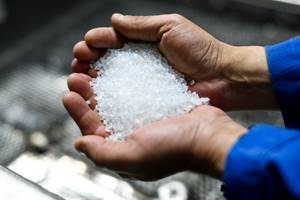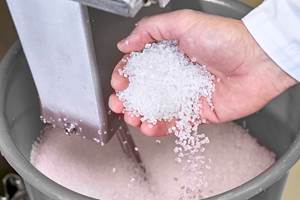Treofan Simplifies Laminate Structure; Boosts Sealing Performance of BOPP Films
ExxonMobil’s Vistamaxx featured in new five-layer BOPP Film.
ExxonMobil’s Vistamaxx featured in new five-layer BOPP Film.
Metallocene PE (mPE) elastomers, whether they serve as a component of multilayer film and/or sheet structures, or as an additive that boosts the performance of molded parts are by now recognized as one of the major plastic material technologies to emerge within the last two decades.
A report released earlier this year noted that North America has accounted for the largest share of the global mPE market and will continue in the lead through 2020, due to increasing demand from various end-use industries such as packaging, electronics, and pharmaceuticals.
The report also identified the film segment as the leading application, driven primarily by the continued growth of the packaging industry, followed by the sheet segment, which is driven by end-use applications such as lamination, thermoforming, and machining.
Prominent players in the mPE market are: Dow Chemical, ExxonMobil Chemical, Chevron Phillips Chemical, LyondellBasell Industries and Total Petrochemicals. Just recently, we reported on SABIC’s entry into this 大象传媒.
One thing that’s clear to this editor is that most of the innovation that continues to emerge comes from savvy plastics processors in collaboration with the material suppliers and brand owners. This is particularly evident in the food packaging industry, which continues to evolve as such partners look to produce better, more efficient, more economical packaging that also manages to be more sustainable and attractive.
Here is a look at a recent example. Global BOPP film producer Treofan, Raunheim, Germany (U.S. office in Winston-Salem, N.C.) has developed a new five-layer BOPP film which features Vistamaxx metallocene-catalyzed olefinic TPEs from ExxonMobil Chemical, resulting in a simplified laminate structure with excellent sealing performance.
Treofan’s aim was to develop a BOPP film for the packaging of instant soups, but one that would also serve well for other kinds of dehydrated powdered products such as spice blends or instant sauces. Current laminates for soup pouches are typically comprised of a 7-9 µm aluminum foil and a sealant, made of PE, with a thickness of 10-30 µm. The PE sealant is either a blown film, adhesive laminated to aluminum foil or directly extrusion coated on the aluminum foil.
The company developed the new Treofan MSB 30, a metallized BOPP film using Vistamaxx in the heat-sealable side, replacing the aluminum foil and PE sealant; it allows the number of laminate components to be reduced from three to two layers. According to Treofan, many brand owners prefer printed paper on the outside of the soup pouch. Instead of printed paper, a reverse-printed BOPP film or a printed PET film can be applied to an MSB 30 produced pouch, offering full product design latitude.
According to ExxonMobil, market reference laminates offer a minimum seal strength of 5N/15 mm, which cannot be achieved with a standard BOPP film as the sealant. Treofan MSB 30-based laminate, however, offers a seal strength of about 8N/15 mm and even higher if desired. Seal integrity (hermeticity) reportedly is also enhanced. SKYE tests indicate a much higher overpressure versus a standard BOPP film. According to Treofan, several brand owners and converters have been running samples of MSB 30 recently. “Application tests of our film usually takes 6-12 months,” said Detlef Hutt, innovation engineer at Treofan.

Related Content
Prices for All Volume Resins Head Down at End of 2023
Flat-to-downward trajectory for at least this month.
Read MorePrices Up for All Volume Resins
First quarter was ending up with upward pricing, primarily due to higher feedstock costs and not supply/demand fundamentals.
Read MorePrices for PE, PS, PVC, PET Trending Flat; PP to Drop
Despite price increase nominations going into second quarter, it appeared there was potential for generally flat pricing with the exception of a major downward correction for PP.
Read MorePrices of All Five Commodity Plastics On the Way Up
Despite earlier anticipated rollover in prices for most of the volume commodity resins, prices were generally on the way up for all going into the third month of first quarter.
Read MoreRead Next
Beyond Prototypes: 8 Ways the Plastics Industry Is Using 3D Printing
Plastics processors are finding applications for 3D printing around the plant and across the supply chain. Here are 8 examples to look for at NPE2024.
Read MoreSee Recyclers Close the Loop on Trade Show Production Scrap at NPE2024
A collaboration between show organizer PLASTICS, recycler CPR and size reduction experts WEIMA and Conair recovered and recycled all production scrap at NPE2024.
Read MoreMaking the Circular Economy a Reality
Driven by brand owner demands and new worldwide legislation, the entire supply chain is working toward the shift to circularity, with some evidence the circular economy has already begun.
Read More













